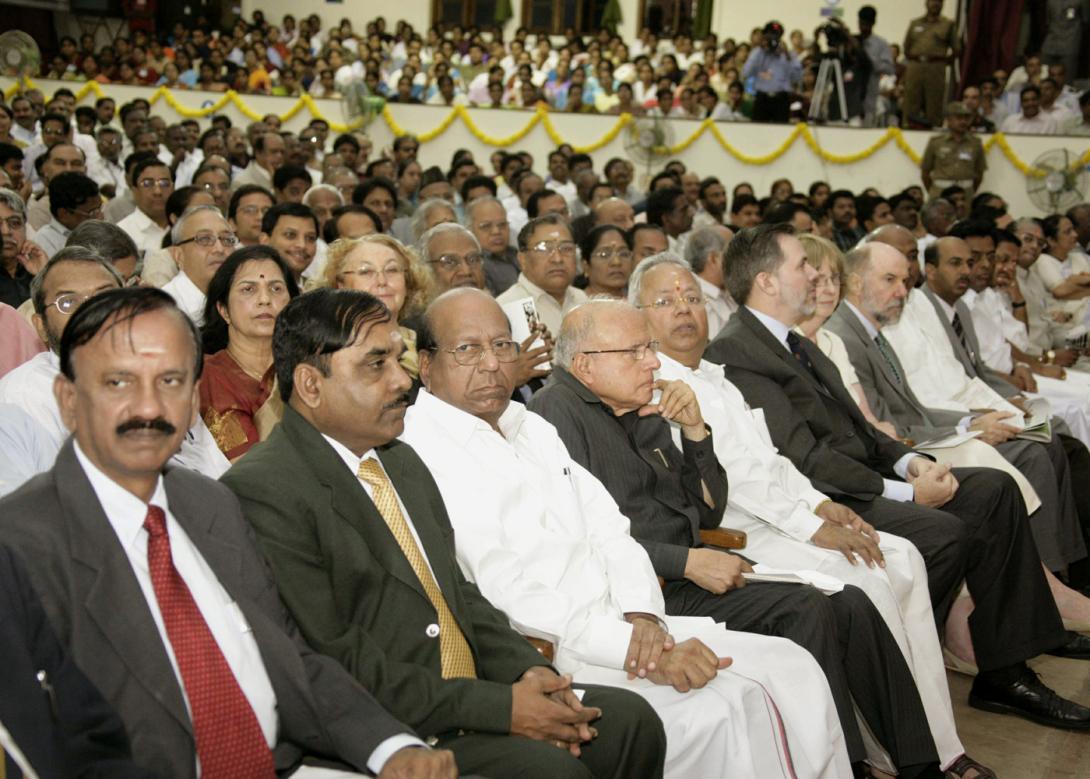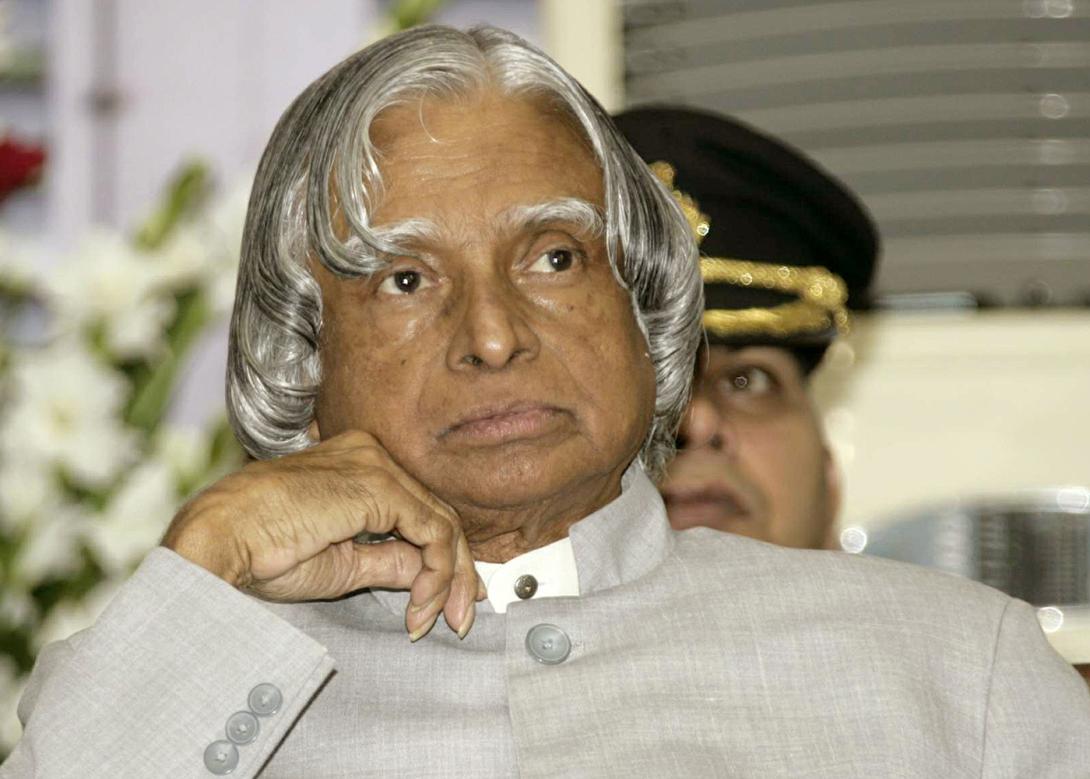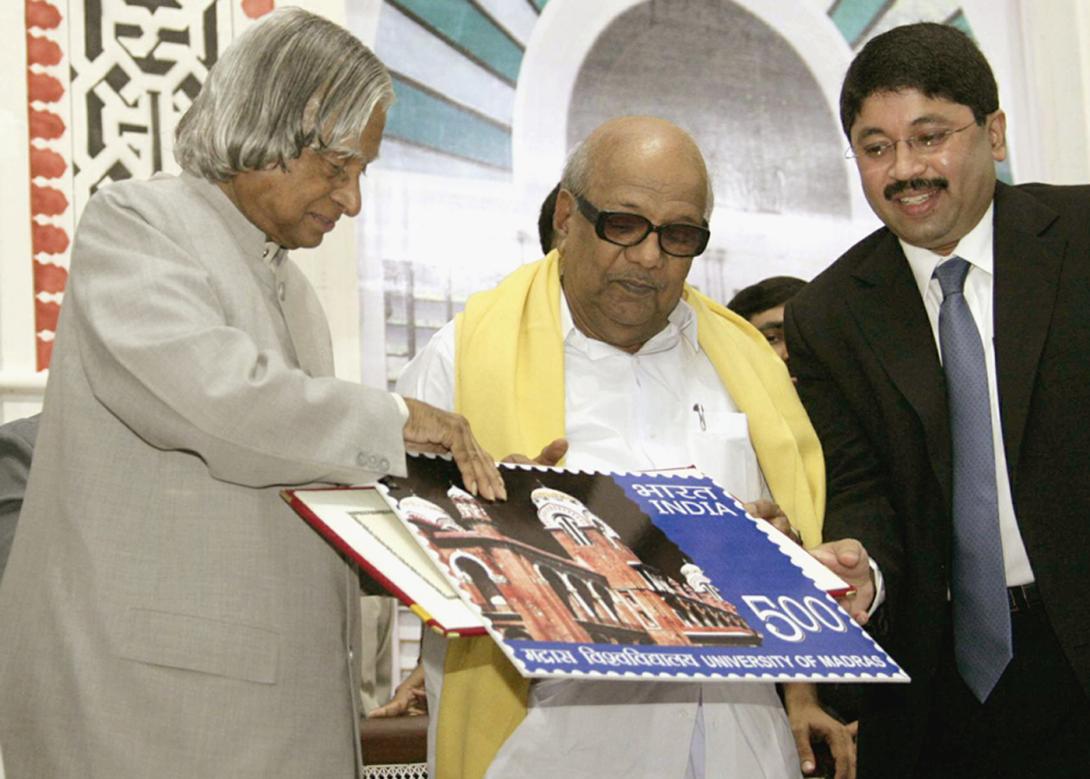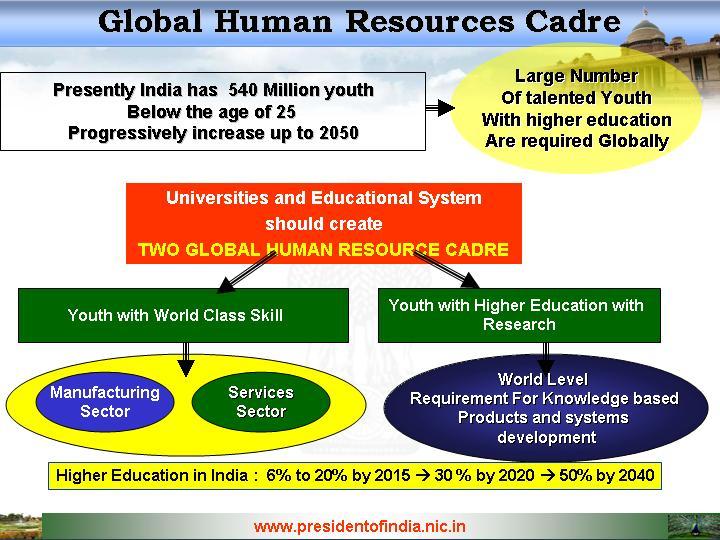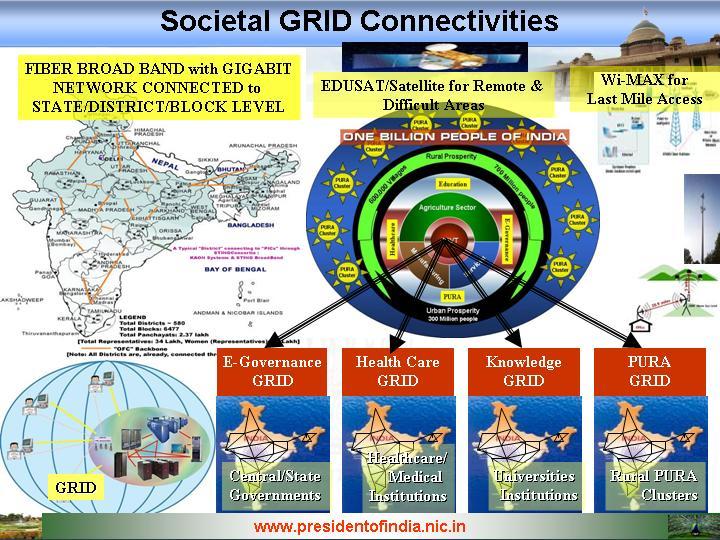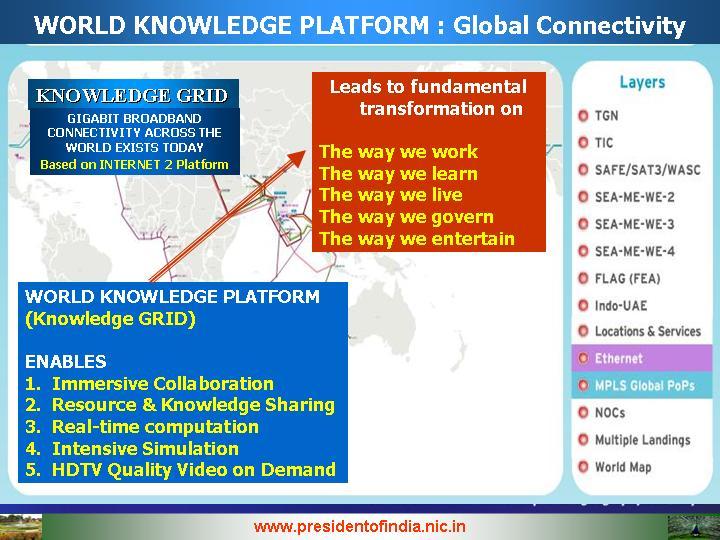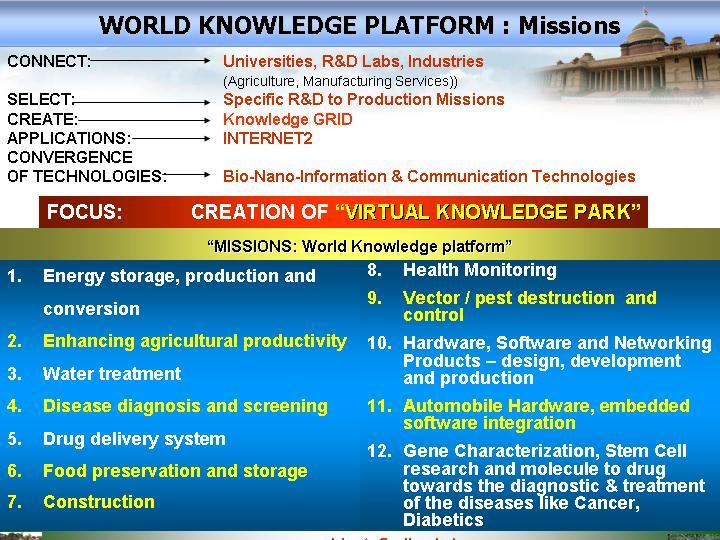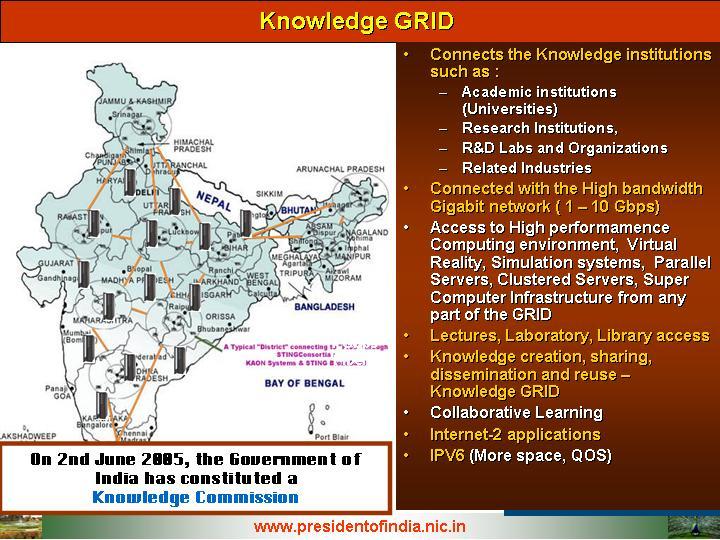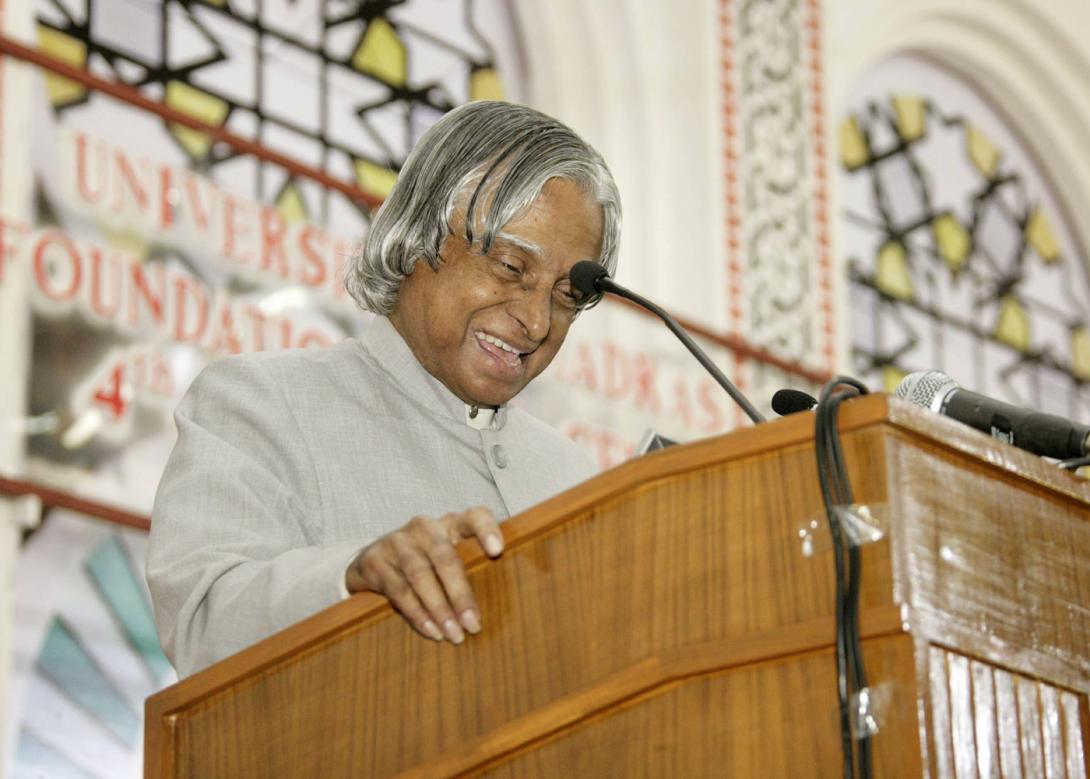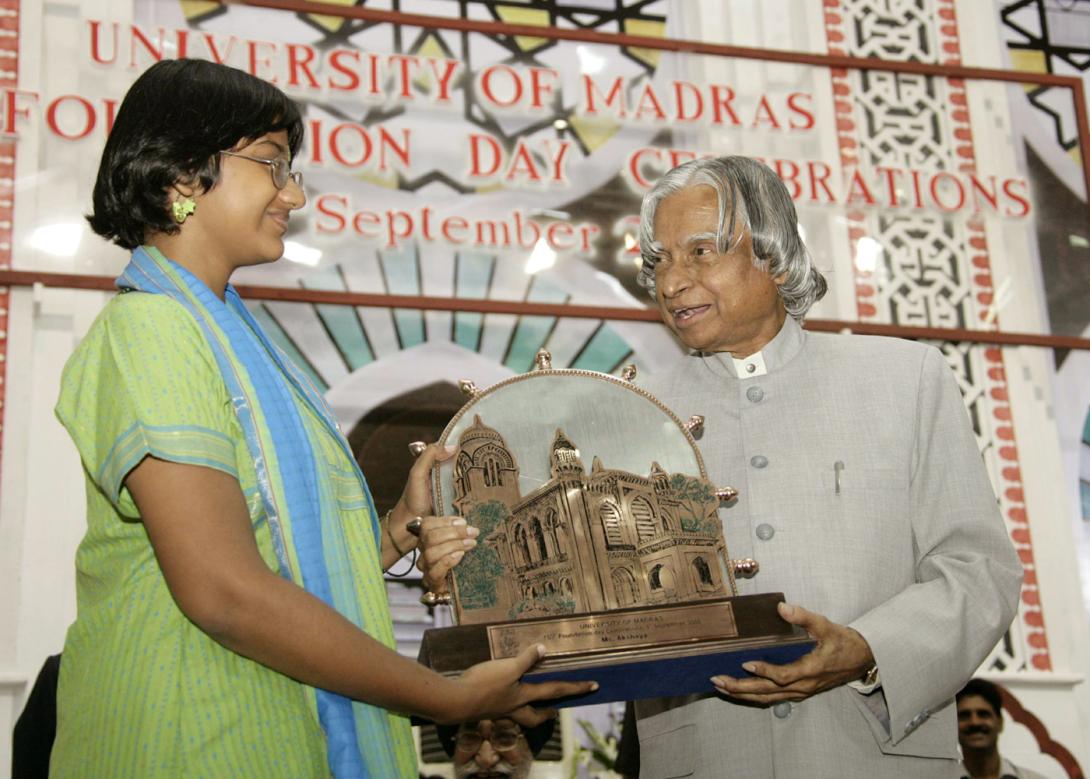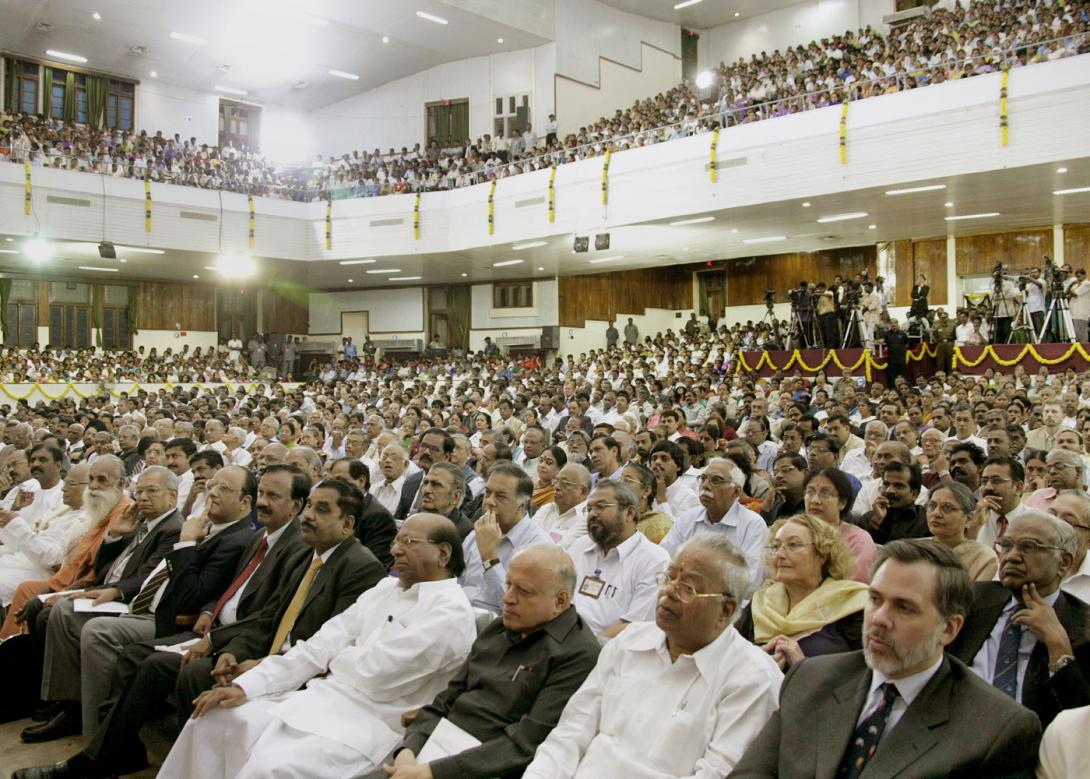Adderss at the Inauguration of the 150th Year Celebrations of the University of Madras, Chennai
Chennai : 04-09-2006
University System for a Knowledge Era

My reminiscences with Madras University
As soon as I entered the University Campus, the first thought which came to my mind, was my college days in Madras University during the period 1950 ? 1954 in St. Joseph?s College, Trichy. This is a very important period, not only because I had the fortune of belonging to this great university and the great Jesuit College, but also I had extraordinary teachers who shaped my life. I recall the way Prof Thothathri Iyengar taught complex numbers and number theory, Prof. Suryanarayana Sastry taught advance mathematics including astronomy and Calculas Srinivasan taught calculas.
I remember Rev Father TN Sequiera teaching Shakespeare. People used to say even Shakespeare will be moved if he hears his lecture. It was true. He was also our new Hostel Warden. Every day Father Sequiera used to make a night visit to the hostels. It was called Father?s visit. One day, I recall. my room mate M Sachithanandam was not well. When Father Sequiera met him he asked him what was the problem. He told him that he was having headache. For immediate relief, Father took aspirin from his robe and gave him the tablet. With concern, he immediately sent him to the doctor and gave one inland letter and asked him to write to his parents, because Father Sequiera came to know that he was not writing to his parents. This is a beautiful experience and learning for me. In St. Joseph?s College Library, Father Sequiera used to take special English class between 6 to 7 PM in the evenings for students who came from Tamil medium schools. He also initiated us to read novels and biographies in simple English. Another great teacher, who is a living legend now is Prof. Chinnadurai. He taught me physics, particularly nuclear physics and light. The way the Professor taught, many students started loving physics, particularly nuclear physics. Now Rev Father Chinnadurai in his 90?s is staying in Dindugal. I have met him number of times, I am going to see him again in Dindugal to give my respects.
They were all great teachers. Whenever they took a class the classrooms were overflowing, because of the way they made the subjects so interesting. Another teacher, I adore is Shri Ayyam Perumal Konar, my tamil teacher.
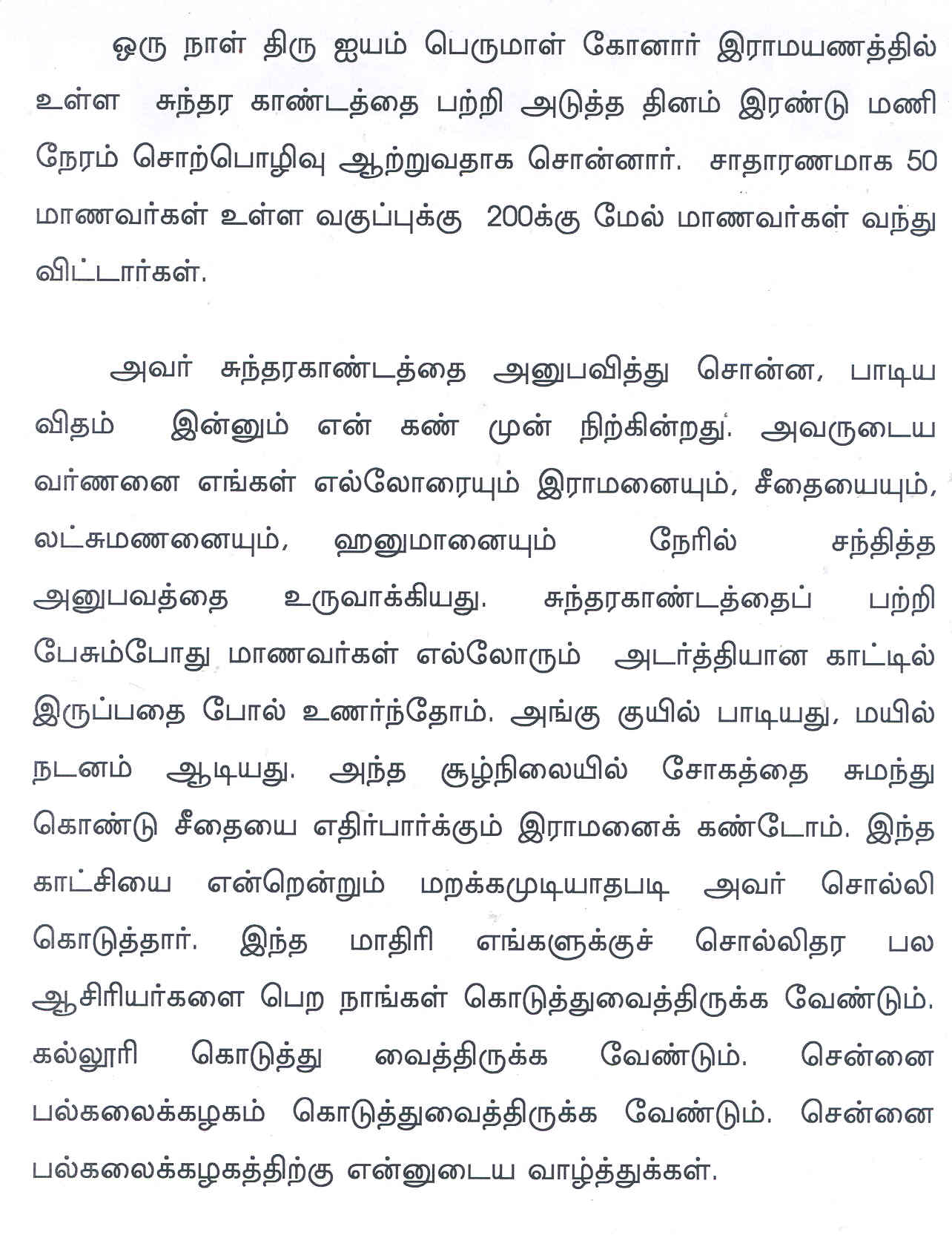
These examples show how teachers can influence the students not only by teaching but also giving practical lessons in human values. They become role models and create lasting impression in the minds of the students. These are great personalities who not only teach but enrich the University.
Golden Jubilee and its dimensions
I am indeed delighted to be in the University of Madras to participate in the Post-Centenary Golden Jubilee Celebrations and the National Seminar on Talents - Technology and Knowledge Power for India. I take this opportunity to congratulate all the teachers, students and staff of this renowned University and all those who have contributed during various phases of the university in promoting excellence in educational standards during the last 150 years. The University indeed has created many eminent teachers, professors, scientists, economists and distinguished personalities. Your University is singularly fortunate to have had the association of many distinguished personalities in its 150 years of educational excellence including distinguished leaders in various fields: Dr. C. Rajagopalachari, Dr. Sarvapalli Radhakrishnan, Shri Neelam Sanjeeva Reddy, Sir C.V. Raman, Dr. C. Subramaniam, Dr. G.N. Ramachandran and many more were the alumni of University of Madras.
An Inspiring educationist: While I am with you, I would like to talk about Sir A Lakshmanaswami Mudaliar who was an inspiring personality for all of us when we were studying. He served as the Vice Chancellor of the University of Madras for a record period of twenty seven years from 1942 to 1969. I remember the day when I had the privilege of receiving a price during my second year in Madras Institute of Technology. Dr. A. Lakshmanaswami Mudaliar was an eminent gynecologist, who practiced gynecology even while he was serving as the Vice Chancellor of the University of Madras. Dr. A.L. Mudaliar?s book on gynecology for the M.B.B.S. students is still a Bible for the medical students of our country. During his tenure he made University of Madras into a research university with several innovative research departments. The establishment of Central Leather Research Institute at Chennai was facilitated by the cooperative attitude of Dr. A.L. Mudaliar. He also established the post-graduate institute of basic medical sciences at the Taramani campus of University of Madras for promoting international quality medical research in collaboration with clinical institutions in Tamil Nadu. The emphasis given by Dr. A.L. Mudaliar on research should be reinforced for graduating Madras University as one of the top universities in the world.
When we remember the past, we should also look at the present, which meets the past and creates the future. Hence, I would like to share with you about one recent incident about the University of Madras, which I came to know through one of the email to me. One retired person from Hyderabad wanted to get M.A degree certificate for her daughter Ms. Kavitha after 16 years of her course completion through the Institute of Correspondence Education in Madras University. He describes that due to earlier experience, getting the old certificate is a big task; he felt it may be difficult and it involves lot of paperwork and may take lot of time. But with less hope, he went to the Madras university website and had simply sent an email to the Vice Chancellor by providing the details. But for a surprise with in one week, the MA degree was sent to his home with a proper reply from the Vice Chancellor. This one incident shows how the University of Madras has been made vibrant in responding to a student?s request. I congratulate the University Staff and the Vice Chancellor for setting up the responsive University System.
Research-Teaching-Research
Good teaching emanates from Research. The teachers? love for research and their experience in research are vital for the growth of the institution. Any University is judged by the level and extent of the research work it accomplishes. This sets in a regenerative cycle of excellence. Experience of research leads to quality teaching and quality teaching imparted to the young in turn enriches the research.
Technology is the non-linear tool available to humanity, which can affect fundamental changes in the ground rules of economic competitiveness. Science is linked to technology through applications. Technology is linked to economy and environment through manufacture of knowledge products. Economy and environment are linked to technology, which promotes prosperity to the society. We have to use innovation to generate high value added products for becoming a global player. Your university is traditionally known for scientific research and teaching. This has to be consolidated and the expanded research areas of the University of Madras must be linked to the priorities of the state and the nation. Now, I would like to discuss about the capacities which are required to be built in students by the University.
Capacity Building
The Madras University with its 150 years of heritage and its forward looking abilities in arts, science and technology can sow the seeds of capacity building among the students. A good educational model is the need of the hour to ensure that the students grow to contribute towards the economic growth of a nation. The university will have to continuously innovate making use of modern technology. The capacities which are required to be built are research and enquiry, creativity and innovation, use of high technology, entrepreneurial and moral leadership.
Research and enquiry: The 21st century is about the management of all the knowledge and information we have generated and the value addition we bring to it. We must give our students the skills with which they find a way through the sea of knowledge that we have created and continue with life long learning. Today, we have the ability, through technology, to really and truly teach ourselves to become the life-long learners. This is required for sustained economic development.
Creativity and innovation: The management of knowledge in the 21st century is beyond the capacity of a single individual. The amount of information that we have around is overwhelming. The management of knowledge therefore must move out of the realm of the individual and shift into the realm of the networked groups. The students must learn how to manage knowledge collectively. When the information is networked the power and utility of the information grows as square as stated by Metcalfe's law. Information that is static does not grow. In the new digital economy information that is circulated creates innovation and contributes to national wealth.
Capacity to use high technology: Every student in our colleges should learn to know how to use the latest technologies for aiding their learning process. Universities should equip themselves with adequate computing equipment, laboratory equipments, and Internet facilities and provide an environment for the students to enhance their learning ability. In the midst of all of the technological innovations and revolutions we cannot think that the role of the teachers will be diminished. In fact the teacher will become even more important and the whole world of education will become teacher assisted and would help in "tele-porting" the best teacher to every nook and corner of the country and propagate the knowledge. The virtual university created between Universities of Madras, Mumbai and Kolkata is a good step forward in this direction for knowledge sharing and outreach in the remote areas.
Entrepreneurship: The aptitude for entrepreneurship should be cultivated right from the beginning and in the university environment. We must teach our students to take calculated risks for the sake of larger gain, but within the ethos of good business. They should also cultivate a disposition to do things right. This capacity will enable them to take up challenging tasks later. In this connection, the University may consider reinforcing a team work with the industries and financial institutions in the State. This will particularly enable generation of entrepreneurs from Madras University for implementing PURA Clusters.
Moral leadership: Moral leadership involves two aspects. First it requires the ability to have compelling and powerful dreams or visions of human betterment. Moral leadership requires a disposition to do the right thing and influence others also to do right things. How it can be achieved? Let me narrate.
Elevating the young minds: While I was in college, I remember the lectures given by highest authority of the Jesuit institution Rev Father Rector Kalathil of St. Joshep?s college, Trichirappalli, Tamilnadu. Every week on Monday, he used to take class for an hour talking about good human beings, present and past, and what makes a good human being. In this class, he used to give lectures on personalities such as Buddha, Confucius, St. Augustine, Califa Omar, Mahatma Gandhi, Einstein, Abraham Lincoln including some scientific personalities and moral stories linked to our civilizational heritage. He also used to talk about great personalities living in the father?s lodge and who had made contribution with values in the service of the people. It is essential in the secondary schools and colleges to arrange a lecture by a great teacher of the institution once in a week for one hour on India?s civilizational heritage. This class can be called as a Moral Science Class. That will elevate the young minds to love the country, to love the other human beings and elevate the young to higher planes.
If we develop in all our students these five capacities, we will produce "Autonomous Learner" a self-directed, self controlled, lifelong learner who will have the capacity to both, respect authority and at the same time is capable of questioning authority, in an appropriate manner. These are the leaders who would work together as a "Self-organizing Network" and transform the nation as a prosperous nation. The most important part of the education is to imbibe the confidence among the students is the spirit of "we can do it". Now, I would like to talk about the pioneering effort in Virtual University.
India's First Virtual University
I would like to congratulate, University of Madras for pioneering Virtual University in partnership with University of Mumbai and University of Calcutta. This Virtual University system has led to the commencement of 10 joint degree, post graduate and Ph.D Programmes. I am very happy that this movement is first of its kind in the country. I had inaugurated this programme from Rashtrapati Bhavan, New Delhi through a Virtual Tele-Education delivery system, where 15,000 students participated. I took the first class for 90 minutes followed by an interaction with the students from all the three universities.
I still remember one of the questions asked by B. Sailakshmi of III B.Sc. Chemistry, Chellammal Women?s College "As a youth how do you think I can transform India into a developed country?" It is a very important question. As a student, the first and foremost mission is to excel in your studies. Next, while being in college, the students can use holidays to educate at least five people who cannot read and write. Students can plant five trees in school premises or neighbouring areas and nurture them. Students can participate in energy and water saving missions. Students can assist in keeping themselves, their homes, their surroundings neighbourhood and environment clean and tidy. Students should lead a honest life free from all corruption and set an example for others including their homes to adopt a righteous way of life. Students should realize whatever work they do if they do the best; they are contributing towards realizing the vision of developed India 2020.
Today I am very happy to inaugurate the Virtual University Portal, which is going to be the single window for providing access to all the three university students in active participation with the Universities of Mumbai and Calcutta. Now, let me come to global connectivity experience.
Borderless world
On 31 May 2006, I addressed the US-India summit on Education, Research and Technology organized by University of California, Santiago and Callit2 in partnership with Department of Science and Technology. It is a unique Multimedia Tele-Conference between India and USA through a high bandwidth network. The High Definition systems has been used at both ends and using the Virtual tele-education platform from Rashtrapati Bhavan Multimedia Studio. An integrated action by a number of public and private organizations both from India and USA worked together to establish the hassle free high bandwidth connectivity between Rashtrapati Bhavan and UCSD. Through this high bandwidth connectivity, the US audience felt my virtual presence in their hall through a high definition projection system in big screen for the whole duration of my lecture and interactive question answer session for around 90 minutes. I felt that the audience was really with me, even though it is virtual and 12,000 km away. During the lecture, I could refer my website, digital library, whiteboard along with my power point presentation on line through the Virtual Tele-ED platform. This experience made me realize the power of technology as an integrator of minds leading to a borderless world without geographical barriers ? a symbol of universalisation. This power of networking can definitely be used by University of Madras for providing quality education to students located in different parts of the State. Bandwidth is the demolisher of imbalances and a great leveler in the knowledge society.
In the world of Virtual Universities the equitable access to all its participants is the primary goal. Unlike in the real world, the equitable access is always the democratic average, in the Virtual Universities the equitable access always means the equitable access to the best resources ? be it the teachers, be it the library, be it the laboratory, available across the network. In effect, the network brings the best of its participants to every one of its participants. The three phases of learning are the lectures, library and laboratories. They require increasing bandwidth from a few 100?s of kilobytes for the lectures to a few megabytes for the formal digital libraries and the informal world of knowledge from the Internet, to gigabits of connectivity for remote laboratories in the world of high precision science and engineering. As the bandwidth becomes cheaper and available in abundance, universities should be able to run remote instruments and facilities as complex as NMR to Wind tunnels. These are applications that can make a difference in how we engage in teaching, learning, and research in higher education.
Since I am in the student?s environment of the University of Madras, I would like to talk to you friends, what type of India we are all working for and what are the opportunities India will present to you. Inter-connectivity among universities, national and international, and other research and development organizations can accelerate knowledge multiplication for meeting national challenges.
Our National Mission ? Challenges
Our nation is going through a major challenge of uplifting of 220 million people who are below the poverty line out of the one billon plus people. They need habitat, they need food, they need health care, and they need education and employment finally resulting in a good life. Our GDP is growing at nearly 8% per annum. Whereas, the economists suggest that to uplift the people from below the poverty line, our economy has to grow at the rate of an additional minimum of 2% per annum consistently, for over a decade.
Integrated Action for Development
Our mission of transforming India into a Developed Nation is to meet the needs of one billion people. We have identified five areas where India has core competencies for integrated action: (1) Agriculture and food processing (2) Education and Healthcare (3) Infrastructure for all parts of the country such as reliable and quality electric power and surface and air transport (4) Information and Communication Technology (5) Self-reliance in Strategic sectors. These five areas are closely inter-related and when effectively addressed, would lead to food, economic, energy and national security and lead to sustainable prosperity.
Engines for Growth
Emphasis should be on full utilization of natural and human resources of the region to meet the demands of modern society. We should also remember that our population consists of 540 million youth, with aspirations for a better life and they are the great strength of the nation. They have to contribute in value addition to agriculture, manufacturing and service sectors of the economy, building on the regions? core competencies and technologies. This action of the youth will lead to higher incomes and employment opportunities and therefore higher growth rates. While you are studying you have to develop necessary skills in your selected discipline may be in science, arts, commerce, humanities, engineering, law, management, IT. For a holistic growth of the nation excellence in individual areas and confluence of disciplines has to take place. The university education system should prepare the students not only acquiring knowledge in their chosen subject but also promote human values and societal transformation skills.
Global Human Resources Cadre
In the 21st century, world needs large number of talented youth with higher education for the task of knowledge acquisition, knowledge imparting, knowledge creation and knowledge sharing. At present, India has five hundred and forty million youth under the age of 25 which will continuously be growing till the year 2050. Keeping this resource in mind, the Universities and educational systems in India have to create two cadres of personnel: (1) Youth with expertise on special skills (2) Youth with higher education with research and technology expertise. These two cadres will be required not only for powering the manufacturing and services sector of India but also will be needed for fulfilling the human resource requirements of various countries. It is essential to increase the through put of the higher education system from the existing 6% to 20% by the year 2015, 30% by the year 2020 and 50% by the year 2040. Others who are not covered by the higher education system will have world class skill sets. With the availability of global human resource cadre, the societal transformation can be efficiently accomplished through societal grid.
Technology to Society - Societal Grid
Development of technologies and their convergence have significant influence on the society in terms of knowledge, health care, governance and economic development. To maximize the synergy between the various components of education, healthcare, e-governance, rural development we need to establish connectivities among them. These connectivities will certainly bring seamless access and information flow among the various domains leading to maximization of GDP and productivity; hence, there is need for establishing the GRIDs namely Knowledge grid, healthcare grid, e-governance grid and the PURA (Providing Urban Amenities in Rural Areas) grid. This interconnecting grid will be known as societal grid. Knowledge sharing, knowledge utilization and knowledge re-use is very vital by all constituents of the society for promoting non-linear growth. With this transformation, India is poised for creating the World Knowledge Platform for promoting synergy amongst partner nations. This will blossom with the enabling environment of trust and confidence between all partners.
World Knowledge Platform
During my recent visit to Singapore, Philippines and Republic of Korea early this month, I have put forward the concept of "World Knowledge Platform", which will integrate the core competencies of the partner countries to develop knowledge products. This platform will enable joint design, development, cost effective production and marketing of the knowledge products in various domains based on the core competence of partner nations to international market.
Knowledge GRID: Initially, the mission of World Knowledge Platform is to connect and network the R&D Institutions, Universities and Industries using fiber broadband from the partner nations on selected R&D Missions. The underground fiber cable infrastructure already exists between the many partners. It is only waiting to be lighted up with state-of-the-art optical networks and to ignite the minds of the knowledge workers. This knowledge GRID will support multitude of seamless connections supporting both synchronous and asynchronous communication, carrying either text or audio or video. We can then use this network in the academic environments to teach courses online and share expensive equipments remotely. In the Industrial environment, it can be used to design complex systems ? even ones that are as complex as an aircraft in a collaborative way using virtual prototyping concepts in the cyber space.
In India, we have today an example of a successful joint venture which harnessed the core competencies of two nation India and Russia, who have different cultures, languages and design standards. The product which has come out is of world class Brahmos supersonic missile system, much ahead of other countries due to the joint working of best of minds from both countries.
Missions of World Knowledge Platform: The convergence of Bio, Nano and ICT is expected to touch every area of concern to the humanity. The "World Knowledge platform" will take up the missions, in some of the areas given below, which are of utmost urgency to all of us to make our world a safe, sustainable and peaceful and prosperous place to live. The areas are: Energy, Water, Healthcare, Agriculture and Food processing, Knowledge products in ICT, Transportation sector, Herbal and natural products and Space Exploration.
Conclusion
Country is moving into a knowledge era. There is a need for transforming our society in to a knowledge society fast. University of Madras with its inherent strength in research and teaching has taken a pioneering action in establishing a virtual university system in India. To reinforce this, it is essential for Tamil Nadu Government to integrate all the other Universities of the State to become partners in the extension of the virtual university. Also for promoting excellence and innovation, the Universities may be empowered with adequate functional autonomy. This will help the higher education system to generate the human capital needed for the knowledge era. This is important since economic development and the evolution of enlightened citizens for the nation will be the focus for the next two decades.
There are few developed countries and a large number of developing countries. When we are in the mission of transforming India into a developed nation, not only increasing the earning potential, employment potential by becoming more competitive but also we must preserve and nurture our unique civilizational heritage. Since the Madras University has a composite education system with emphasis on multiple disciplines like arts, science, humanities, social sciences, commerce, law and management with the heritage of 150 years, it is ideally suited for providing an integrated education to the students that will lead the students to become enlightened citizens who will have a different way of thinking, different way of learning and different way of doing resulting in a different way of life. Thus the University of Madras will be a major contributor for the societal transformation of the nation. I am sure, the Government of Tamil Nadu will be a catalyst in enabling the University of Madras to meet the challenges of the 21st century in the state-of-the-art research and creation of globally competitive human capital.
Once again I greet all the members of Madras University and its colleges on its Post Centenary Golden Jubilee Celebrations and wish you all the best in your missions.
May God bless you.
Question and Answer Session
S. Mohanapriya, Department of Mathematics, Shri Saraswathi College of Education, Ponneri (26)
1. How can we implement technology in school education?
Ans: First of all the schools should have computer facilities, bio, nano, information, science and mathematics laboratories. Now-a-days 3-D animated contents are available for the schools from the 1st standard to 12th standard. For example, children can be taught automobile by taking to a garage and explain all the components and systems. They can also be taken the fields and shown the importance fertilizers, pesticides, seeds matching to the soil. This will be a lasting way of learning and enable the child to understand the technologies involved. Also, there are e-learning programmes which give simulated practical lessons on all subjects. The children can be exposed to such learning methods.
M. Maria Felci Rajati, 2nd Year M.A. English Lit. Loyola College (156)
2. How important is Women Empowerment for a society to be more knowledgeable and powerful as women are the core of India?s familial system?
Ans: If women are empowered stability in society is born.
Akhther Habib Shah, 2nd Year M.A., English Lit., The New College (176)
3. How to make technology and moral education to go hand in hand?
Ans: Moral education gives the character to the individual, family and to the society.
C. Indira, 1st Year B.Sc., Mathematics, CSI Women Christian College (197)
4. How can talents and technologies be used to ensure that our natural environment and biodiversity flourish?
Ans: All education must emphasize the need for preserving the environment. Right from school days students should be taught to ensure they do not keep on taking everything away from nature without giving back to it. Children at young get can plant trees, keep their areas clean and be taught on pollution related aspects. I have seen a school in Almora is asking the students to map the environment in their area by giving them certain gadgets like global position systems and compass and the computer for recording the details digitally. This enables the civic agencies to take appropriate action for preventing environmental degradation.
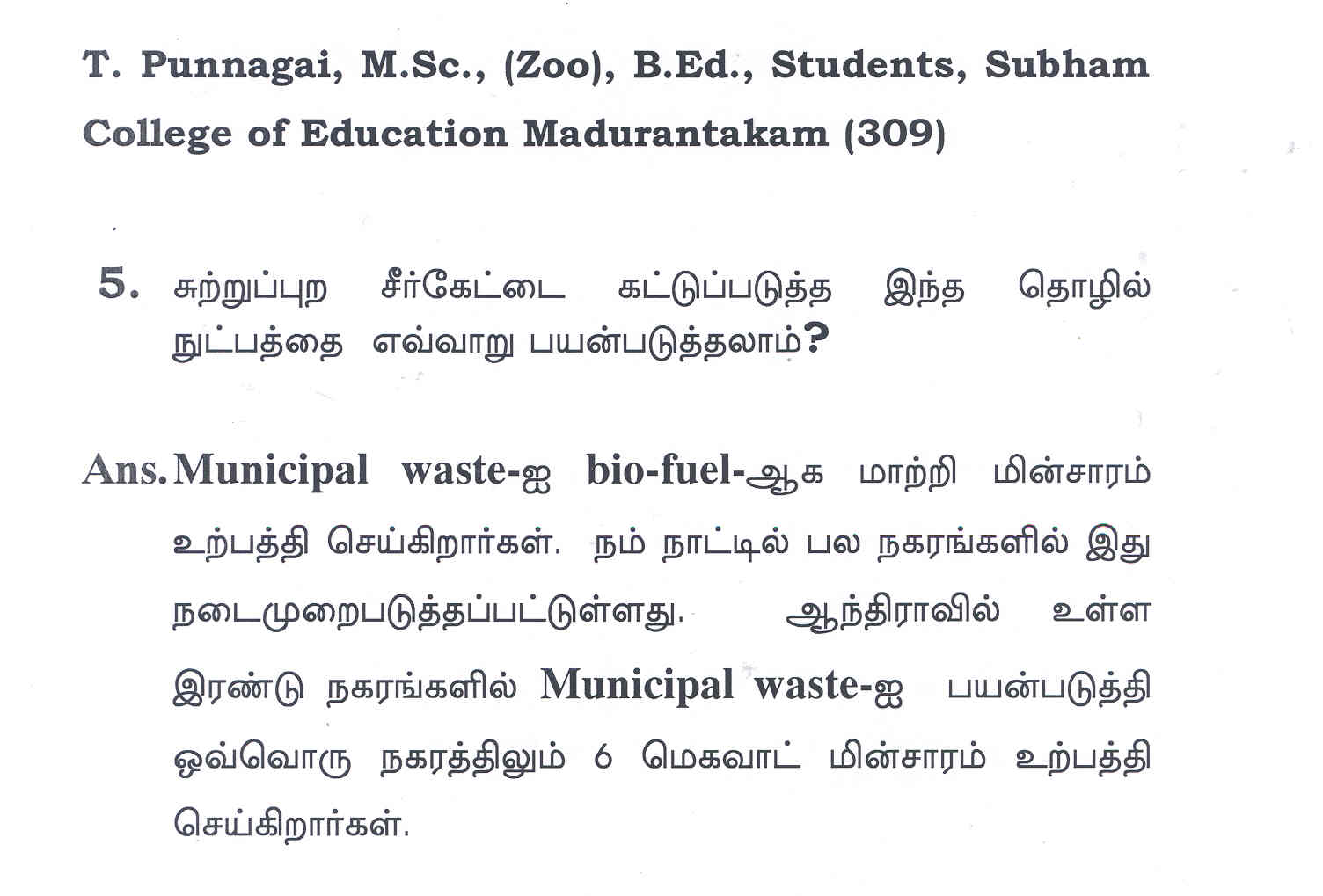
Sangetha V.S., 2nd Year B.Sc., Meenakshi College for Women, Chennai (433)
6. Why is India lagging behind in the Olympics despite having a large population and substantial fund allocation in the budget for the development of sports?
Ans: Two new schemes has been established. One by the Army and the other by the Ministry of Sports. These two schemes are identifying the sports talents from the young age and nurturing them towards excellence and meet international standards. Achieving excellence at the highest level in any field requires total concentration on one particular field. Talents, acquisition of knowledge, training, perseverance hard work are the four ingredients for success. In our case we tend to work for sports along with preparing for livelihood. This situation is slowly changing. I am sure in the years to come through individual, family, societal, and governmental awakening, we will be having world class sportsmen. I am getting this confidence from the youth I am meeting during my visit to various places.
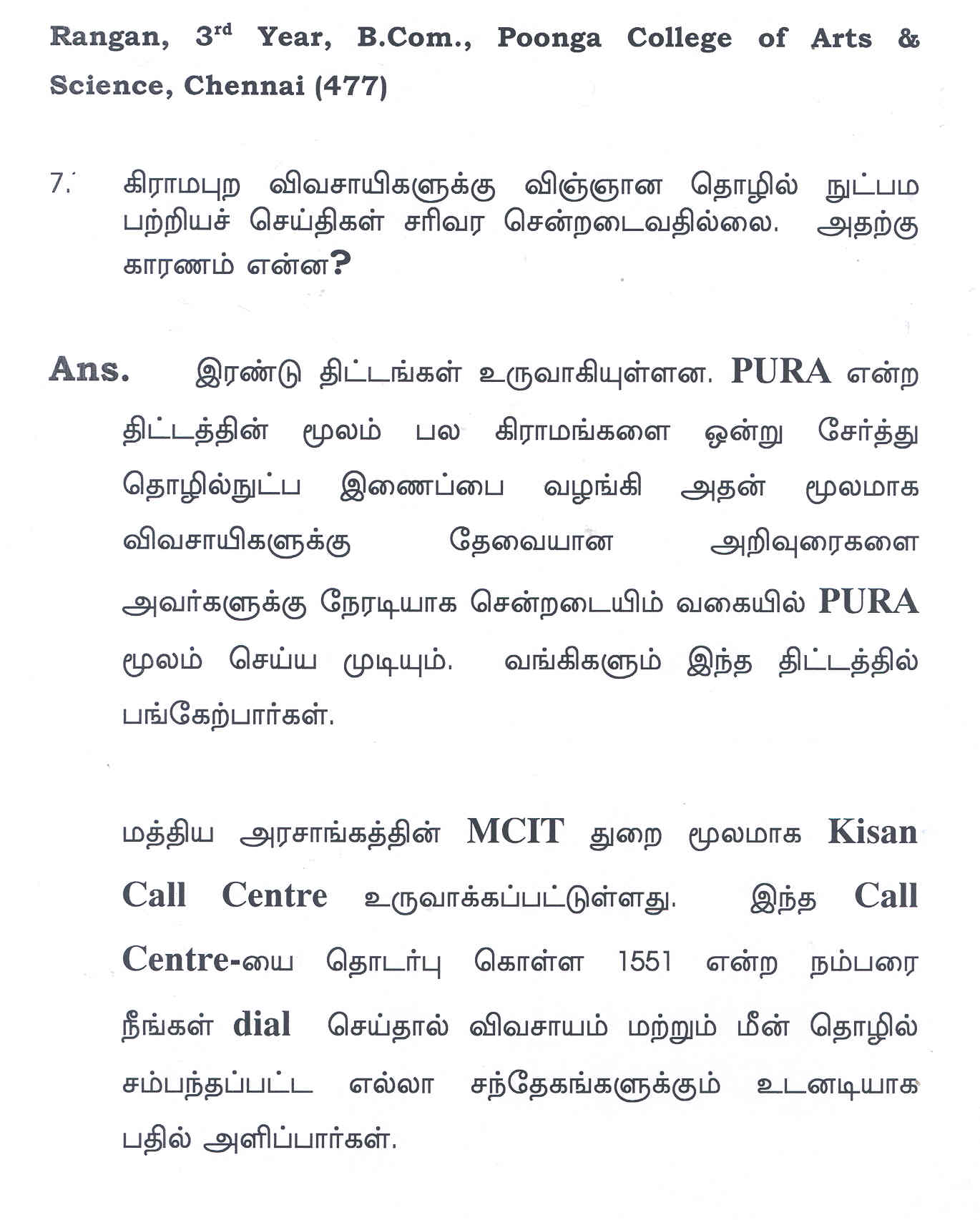
V. Nelavarasan, 2nd Year M.A. Economics., A.M. Jain College, Meenambakkam, Chennai (490)
8. In spite of having good technology why should the price of medicines and health related instruments are very high?
Ans: In India the cost of the medicine compared to many other counries is very low. But we have to ensure thatt the cost does not fluctuate. However the treatment and the hospital stay is becoming costlier. We have to activate primary health centres and large number of mobile clinics for providing quality health care to the needy at affordable cost.
Geetha Shree, 1st Year BCA, TMG College of Arts & Science (513)
9. Though Nano-technology is going to be future technology, why are we not having sufficient research and development in India?
Ans: The government has funded during the few years for nano science and technology research. Focal Department is Departmentof Science and Technology. In Madras Univeristy has been provided a special grant for nano-technology centre by the Government of Tamil Nadu.
John Rua, 2nd Year B.Sc., Visual Communication, Patrician College (525)
10. What can the youth do for the betterment of the country, especially the politics of the country? Do you think politics in India needs younger people?
Ans: This question about the contribution of youth for the betterment of the country, I have already answered during my talk. Regarding politics the youth while studying should work for excelling in their chosen area. After acquiring the knowledge and skill, they can definitely choose politics as a profession. I have been studying the age profile of the Members of Parliament. I find number of young legislators and parliamentarians in the list.
V.J. Deepshica, 1st Year B.Sc., Biotechnology, Kumararani Meena Muthiah College of Arts and Science, Gandhi Nagar, Adyar (574)
11. Can Science play a major role in removing poverty? How
Ans: Science can definitely play a major role in removing poverty. From ship to mouth existence, we are now producing over 200 million tonnes of food-grains. This has come from agricultural science and research. Through space research, we can reach and communicate any remote area in the country. Space science enables monsoon forecasting, crop conditions, availability of fish and natural resources. Nuclear science is used for preservation of food-grains. Science enables us to produce low cost construction material for rural housing.
V. Udhayashankar, 3rd Year B.Com., Sri Shankara Arts & Science College, Kanchipuram (597)
12. Will online teaching affect future of traditional teaching?
Ans: Always, online teaching will remain a complementary system to traditional teaching and enhances the power of the traditional teacher by increasing his reach to a larger students population. Online teaching provides an equitable access of resources to all the people.
N. Lakshmi (B.Com Final Year), Bhaktavatsalam Memorial College for Women Korattur (610)
13. Today's children are tomorrow's leaders, but child labour is still prevalent in India. Why?
Ans: There are laws prohibiting child labour. We should strictly follow. Also it is essential to rehabilitate the child by providing quality life and good life. This is the joint work of government and social minded people.
Mohammed Nazeem, 3rd Year BCA, Annai Veilankanni?s College (620)
14. Unlike other countries, India is a land of many languages. Is it a drawback for the development of technology?
Ans: It is better to learn in mother tongue science and technology. Finally it will happen. Of course there should be a common language. India is a multi-cultural, multi-lingual, multi-religious society. This diversity is a great advantage and must be used for development of technology. For example, in a village in Madhya Pradesh, Villagers are collaborating with JETRO in Japan for producing products which can be sold in the international market. Language has not become a barrier in promoting the right technology. Because of the revolution in communication technology conversion between the one language and the other has become quite easy.
R. Manikanda, 2nd Year B.Com., Dr. Sir. A.L. Mudaliar Vocational Arts & Science College, Vengal (657)
15. How can rural students present their inventions and discoveries to the world? How do you help these kinds of students?
Ans: There is an Innovation Foundation in Indian Institute of Management, Ahmedabad which promotes rural innovation. Every year they invite applicants to put forward their innovation. In addition, National Research and Development Corporation (NRDC) and Technology Information Forecasting and Assessment Council (TIFAC) assist in securing national and international patents for right type of inventions.
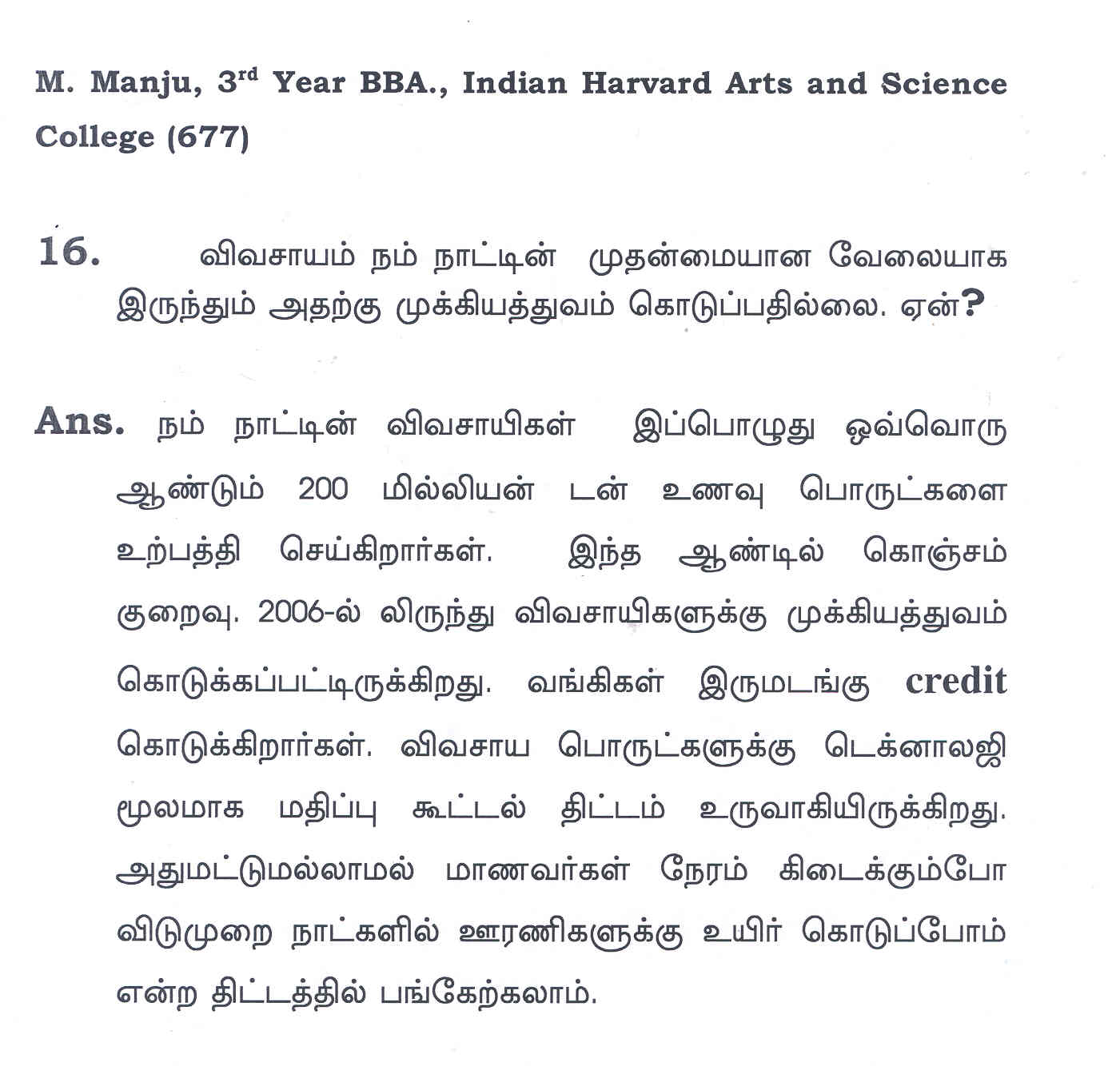
Reeva Jbea Lina J., St. Christopher?s College of Education, Chennai (692)
17. Educational opportunities, that are given to the physically handicapped are not given to the psychologically handicapped ones. This may be due to the lack of adequate facilities to meet the difference in the percentage of disability. Will India solve this problem with the technological advancement?
Ans: There are number of institutions in the country providing help to the psychologically handicapped and also equip them for undertaking certain type of jobs. Institutions like Banyan in Chennai use the training to the person who are mentally ill, whereas, Central Institute of Mental Retardation, Thiruvananthapuram takes care of the mentally challenged children.
M. Annamma Priyadarshini, Maths, Christ College of Education, Kancheepuram (755)
18. There are so many Einsteins and Newtons in rural sectors. The only thing which they lack is communication skill and because of that their talents weren't expressed what do you say about this?
Ans: Of course in our country we may have many budding Sir C.V. Raman, Chandrasekhar Subramaniam, Srinivasa Ramanujan and also the digital divide what we are having today between rural and urban, I am sure will be broken within three years time through a scheme called PURA which gives physical connectivity, electronic connectivity and knowledge connectivity.
Ms. Mandhagini Thulasi, 3rd Year History, Ethiraj College for Women (812)
19. With the increasing terrorist activities, how can we, as students create a harmonious environment among ourselves, at the school and college level, so as to get rid of the ill-feelings that are bred with respect to religion?
Ans: I would like to recall my experience in St. Joseph College in Trichy. I had two class mates one orthodox Iyengar from Srirangam M.D. Santhanam and Mr. Nainan a Christian of Kerala. My friend Santhanam will do everyday Sandhya Vandanam, my Christian friend used to read the Bible everyday morning and I used to do read Kuran and offer Namaz. Our college not only provided the good education but also good way of life by bringing Unity of Minds.
Ms. Divya Sharma, B.Com., Justice Basheer Ahmed Sayeed College for Women (825)
20. Why is it that when we adapt technologies, the quality does not remain the same. What can be done to maintain quality and value?
Ans: You have asked a fantastic question. It is an attitude. It starts from home how one has been trained and educated. Engineering institutions have to play a very important role in imparting quality and quality assurance education. Particularly engineering institutions have to impart practical education to the students and future managers profit comes out of quality. At no time quality can be compromised. Of all countries I have visited two countries impressed me which gives highest importance from the home, education and industry and every walk of life the quality and the standard of life I can see in Switzerland and Singapore and South Korea. How they have achieved is through their steadfastness and hard work with the focus they have to compete with the world market only through by quality. I am sure, the Indian homes, Indian schools, Indian industry establishment will realize to compete in the world they have to have a quality in their way of life, in their way of doing and in their way of action.
Ms. D. Dhanalakshmi, 2nd Year M.Sc., GTA, Queen Mary?s College (835)
21. How will you include us in your dream for India?
Ans: 540 million youth of the nation are the partners for the National Vision ? India 2020. Youth works for mission and mission succeed.

